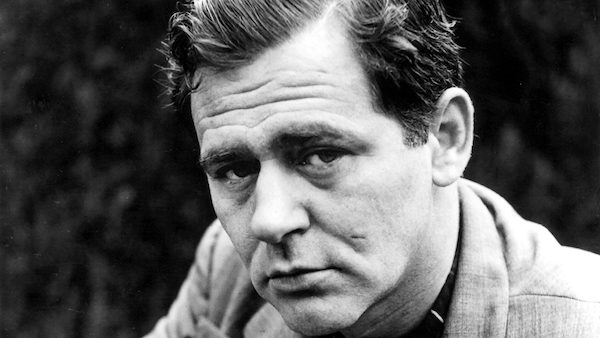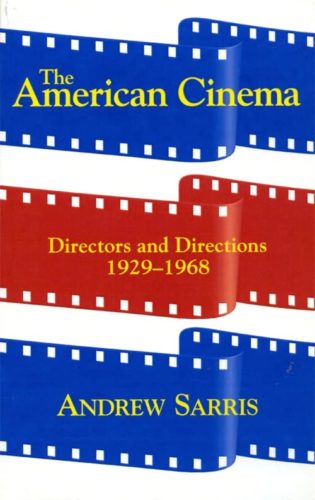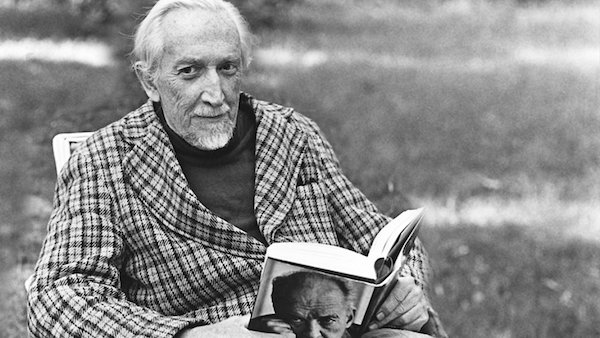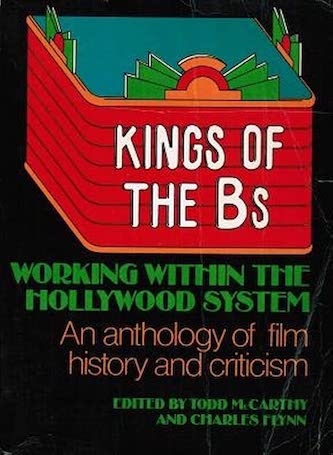Film Commentary: The Books That Shaped My Film Aesthetic
By Gerald Peary
Here’s a personal list of the 25 most important, influential books about American cinema. Only one book per author.

Film critic James Agee — he could write with love and tenderness about all kinds of films, high and low.
I started reading film criticism when I was 16 or so. My parents subscribed in the early ’60s to the literary magazine, The Saturday Review, which featured revolving weeks of reviews by Arthur Knight and Hollis Alpert. Both were competent and intelligent, but, I only realized later, not especially inspired or original in their taste. I next became a regular reader of Bosley Crowther in the New York Times. He was a fine liberal, against the stupidities of war and a strong supporter of civil liberties and the civil rights movement. But, I would realize later, he automatically gave favorable reviews to films which had progressive politics: a good picture was one with a worthy theme. Content over form every time, as Crowther had trouble with “B” movies and anarchic cinema, including comprehending Bonnie and Clyde and much of the French Wave.
And then I bought the 1958 collection, Agee on Film. A revelation. Though James Agee’s reviews were from the ’40s, they were so fresh and immediate. And he was a beautiful, thoughtful writer. Also, there seemed to be no blind spots: he could write with love and tenderness about all kinds of films, high and low. It was Agee who led me to seek out The Best Years of Our Lives, Monsieur Verdoux, and The Treasure of Sierra Madre. Because of Agee, I discovered Buster Keaton, and John Huston became my first favorite film director.
What other film books, after initially reading Agee, managed to affect me, shape my thinking and aesthetics? Here’s a personal list of the 25 most important, influential books published first in English about American cinema. Only one book per author.
 Lillian Ross, Picture (1952) — The New Yorker writer was invited on the set of John Huston’s adaptation of The Red Badge of Courage. The first significant behind-the-scenes on the making of a movie, sharp and revelatory, and perhaps the birth of New Journalism.
Lillian Ross, Picture (1952) — The New Yorker writer was invited on the set of John Huston’s adaptation of The Red Badge of Courage. The first significant behind-the-scenes on the making of a movie, sharp and revelatory, and perhaps the birth of New Journalism.
James Agee, Agee on Film: Reviews and Comments by James Agee (1958) — A collection of Agee’s reviews from Time and The Nation in the ’40s displaying the eloquent literary craft of this caring weekly film critic.
Pauline Kael, I Lost It at the Movies (1965) — The first collection of Kael’s saucy, irreverent, stylish looks at cinema. There were many more haughty, colorful, judgmental books to come.
Carlos Clarens, An Illustrated History of the Horror Film (1967) — An erudite history of the horror genre, including commentary on Nosferatu, the Universal ’30s classics, and the poetic cinema of Val Lewton.
Andrew Sarris, The American Cinema (1968) — Probably the most influential book of them all, the paperback in which Sarris elucidated his auteurist theory of cinema and applied it in a polemical way to the history of American cinema, championing for dazzled readers many unknown esoteric film directors. Later critics have called this book “their Bible.”
Richard Schickel, The Disney Version: The Life, Times, Art and Commerce of Walt Disney (1968) –The first genuinely revisionist study of a major figure in American cinema, the sacred animator entrepreneur made mortal when seen through critic Schickel’s skeptical lens.
Kevin Brownlow, The Parade’s Gone By (1968) — An admiring and definitive oral history of the silent cinema with many excellent interviews of those still surviving in the ’60s from the nostalgic golden years of early Hollywood.
Leonard Maltin, Leonard Maltin’s Movie Guide (1969) — The necessary book on every film lover’s shelf, revised by Maltin every two years, smart mini-reviews of thousands of films, including many very obscure ones, which are available on film, on TV screens, on tapes and DVDs.
 Jim Kitses, Horizons West (1969) — A pioneering study of important directors of American westerns, from Ford and Hawks to Boetticher to Anthony Man, by an astute British film critic.
Jim Kitses, Horizons West (1969) — A pioneering study of important directors of American westerns, from Ford and Hawks to Boetticher to Anthony Man, by an astute British film critic.
Dwight Macdonald, On Movies (1969) — An anthology of Macdonald’s witty, urbane columns from Esquire in which the famous hater of “middlebrow” art writes knowledgeably about high modernist filmmakers and puts down standard Hollywood fare.
Manny Farber, Negative Space: Manny Farber on the Movies (1971) — A choice selection of the idiosyncratic writings of Farber, who penned fan notes to hard-boiled subterranean movies, what he called “termite art,” from the unusual position of a practicing abstract modern artist.
Peter Wollen, Signs and Meaning in the Cinema (1972) — A study of movies from a structuralist point of view, probably the most-read theoretical book about cinema. Also the most coherent and understandable, from a theorist who also genuinely loves the films he discusses.
Jonas Mekas, Movie Journal: The Rise of the New American Cinema, 1959-1971 (1972) — A compendium of Mekas’s Village Voice columns in which he wrote passionately as a booster of the American underground cinema of Maya Deren, Jack Smith, and Stan Brakhage.
Donald Bogle, Toms, Coons, Mulattoes, Mammies and Bucks: an Interpretative History of Blacks in Films (1973) — An African-American scholar shows with sympathy the plight of Black actors forced into stereotyped supporting roles in Hollywood cinema. As Hattie McDaniel asked: is it better to play a maid or be a maid?
Richard Corliss, Talking Pictures: Screenwriters in the American Cinema, 1927-1973 (1974) — The film critic for Time and editor of Film Comment offers a stirring defense of Hollywood screenwriters. Corliss contends that they are forgotten because “auteurist” critics credit the movie’s director as solely responsible for a film’s artistry.
Molly Haskell, From Reverence to Rape: the Treatment of Women in the Movies (1974) — A charming, elegant, early feminist study of the roles played by women, both good and bad, in classic Hollywood films. Even when being critical, Haskell writes with empathy for the female stars behind the performances, as a true devotee of the movies.

Film critic Dwight Macdonald reading Vladimir Nabokov.
Robin Wood, Hitchcock’s Films (1965) — An early model of how to write deep, extended analysis of a director’s work; it includes brilliant defenses of denigrated Hitchcocks such as Marnie.
Todd McCarthy and Charles Flynn, Kings of the Bs (1975) — A first-rate anthology of interviews with filmmakers, producers, exhibitors of low-budget American movies plus learned appreciations of such little-known filmmakers as Joseph H. Lewis.
David Thomson, The Biographical Dictionary of the Film (1976) — Thomson’s unorthodox mini-biographies of actors and directors done with style and insight. This informal dictionary is so popular that it has been revised numerous times since its original publication.
David Bordwell and Kristin Thompson, Film Art: an Introduction (1979) — No book has been used more in film courses across America than this sophisticated, winning text by the superb collaborative team of Bordwell and Thompson. There are not many serious-minded film volumes which are perennial best-sellers, but Film Art: an Introduction keeps being bought, edition after edition.
Vito Russo, The Celluloid Closet: Homosexuality in the Movies (1981) — The muckraking book that dares to look at Hollywood from an openly queer sensibility and exposes how homosexuality has been treated as a shameful aberration in studio pictures. Sadly, Russo would become a victim of AIDS.
 Danny Peary, Cult Movies (1981) — A generous, democratic tribute to all kinds of films which have achieved cult status, from difficult art cinema to inventive genre movies. Many readers have made check-lists of the wide-ranging movies endorsed by the author, and up-and-coming filmmakers swear that this one inspired their careers. (I know the last is true because this book is from my brother!)
Danny Peary, Cult Movies (1981) — A generous, democratic tribute to all kinds of films which have achieved cult status, from difficult art cinema to inventive genre movies. Many readers have made check-lists of the wide-ranging movies endorsed by the author, and up-and-coming filmmakers swear that this one inspired their careers. (I know the last is true because this book is from my brother!)
Ray Carney, American Dreaming: The Films of John Cassavetes and the American Experience (1985) — One of a series of overlapping books on Cassavetes by a Boston University professor. All together, they have made a bold, spirited case for Cassavetes’s genius and have bolstered and helped sustain the director’s exalted reputation.
Carol J. Clover, Men, Women, and Chainsaws: Genre in the Modern Horror Film (1992) — Clover’s theories for how many recent horror and slasher movies operate — a series of bloody murders leading inevitably to the “final girl” survivor — have been not only embraced by academics but taken into consideration by horror filmmakers themselves when formulating their scripts.
Joseph McBride, Searching for John Ford: a Life (2001) — An exemplary film biography, blending every salient detail of director John Ford’s life with every detail a reader would want to know about the making of every Ford movie with, finally, perceptive essays about the films themselves. The rich, affectionate book which America’s greatest filmmaker deserves.
Gerald Peary is a Professor Emeritus at Suffolk University, Boston; ex-curator of the Boston University Cinematheque; and the general editor of the “Conversations with Filmmakers” series from the University Press of Mississippi. A critic for the late Boston Phoenix, he is the author of nine books on cinema; writer-director of the documentaries For the Love of Movies: The Story of American Film Criticism and Archie’s Betty; and a featured actor in the 2013 independent narrative Computer Chess. His latest feature documentary, The Rabbi Goes West, co-directed by Amy Geller, has played at film festivals around the world.
Tagged: Carlos Clarens, Carol J. Clover, Charles Flynn, Danny Peary, David Bordwell, David Thomson, Donald Bogle, Dwight Macdonald, James Agee, Jim Kitses, Jonas Mekas, Joseph McBride, Kevin Brownlow, Kristin Thompson, Leonard Maltin, Lillian Ross, Molly Haskell, Pauline-Kael, Peter Wollen, Ray Carney, Richard Corliss, Robin Wood, Todd McCarthy

Excellent list. I’d also recommend Hollywood Genres by Thomas Schatz. https://www.amazon.com/Hollywood-Genres-Formulas-Filmmaking-Studio/dp/0075536234/ref=sr_1_1?crid=1BM4HS80WTAFC&keywords=Hollywood+Film+Genres+schatz&qid=1678294637&sprefix=hollywood+film+genres+schatz%2Caps%2C86&sr=8-1&ufe=app_do%3Aamzn1.fos.18ed3cb5-28d5-4975-8bc7-93deae8f9840
I agree — but where are the French? What is Cinema? Volume 1 by André Bazin at the very least. And I would add Robert Warshow’s The Immediate Experience, despite some revisionist grumbling. No less than Andrew Sarris choose it and the Bazin as essential works of film criticism. My outlier would be Graham Greene on Film — some wonderfully tasty writing ….
Also From Caligari to Hitler by Siegfried Kracauer, https://www.amazon.com/Caligari-Hitler-Psychological-History-German/dp/0691115192
It’s bad form to tag writers who are no longer alive.
Horizons West was published in the UK, in a book series rooted in the British Film Institute, where Jim Kitses worked in the 1960s, but he’s not British. He was born and raised in, well, the vicinity of Boston.